If you want to turn climate policy into a bitter culture war, there are few more effective weapons than a Big Mac.
On one side, environmentalists would say that the cattle we raise cause about as much greenhouse pollution as all the world’s cars, trucks, ships and planes. On the other, irritated meat lovers would call you a killjoy, and warn you do not win friends with salad. However, there is one place where the opposing groups agree: As incomes rise and allow people to buy more of it, beef eating is such an irresistible habit that only implausibly radical behavioral changes can stop things from spiraling still further out of control.
They are both wrong about that, though. As we have said in the past, the world is rapidly closing in on peak beef. It is possible that the carbon hoofprint of the global cattle herd is already in decline.

Illustration: Mountain People
That is certainly the assessment suggested by the US Department of Agriculture’s (USDA) data. More than 90 percent of the world’s additional demand for meat over the past 15 years has been met by less carbon-intensive products. Consumption of chicken increased by 35 percent, or 27 million tonnes, from 2010 to the agency’s forecast for demand next year, while pork is up by 12 million tonnes, or 12 percent. Beef, whose heavy methane load is due to burped gases from ruminant stomachs that poultry and pigs lack, increased by a mere 3.6 million tonnes, or 6.3 percent.
Such numbers are particularly striking when you consider that the world’s population increased by about 15 percent from 2010 to last year, and the global economy is about 43 percent larger, adjusted for inflation. Our appetite for burgers, steak and mince has not increased at anything like the same rate. This suggests the constraint on beef production is not our guts and wallets, but more fundamental constraints of resource availability.
The same factor that worries environmentalists about beef — its voracious ability to consume land, water, feed crops and the planet’s carbon budget — puts limits on the ability for supplies to grow. Diners might not need to self-consciously reject red meat at all, when the availability of cheaper fish, chicken, pork and vegetarian options is enough to cause an imperceptible shift away from it.
Those factors may already be causing a decline in the worldwide herd, the USDA’s numbers showed. From a peak of more than 1 billion head of cattle in the mid-2000s, stocks at the start of next year would fall to 923 million head, a record low in their data.
That may seem inconsistent with a world in which beef demand is still growing, but in fact it is not. In crowded developed countries, animals spend much of their lives in intensive feedlots, where they are given a grain-based ration to get them to slaughter weight in 18 months or less. This is much more productive than having grass-fed cattle living semi-wild on rangelands. In Brazil, animals can live for three years or more before their trip to the abattoir.
As major producing regions such as Brazil, the US and China intensify their beef production processes and focus on the breeds that grow fastest, we are eking more beef out of a smaller herd. This intensification means pasturelands already cover less area than at any time since the 1970s. In terms of animal welfare, this is not great news — but from the perspective of the climate, it is almost certainly an improvement.
There is one major reason to doubt this optimistic story: Counting the number of bovids spread across vast rangelands is an imprecise business, so it is possible the USDA’s numbers are wrong.
The Food and Agriculture Organization (FAO) has a much higher, and still-growing, estimate for the cattle herd — 1.55 billion head, as opposed to the USDA’s 923 million.
That appears to largely relate to differences in areas such as Africa and west and central Asia less connected to global trade routes, where the market-oriented USDA’s data gathering might be weaker than that of the FAO. Both bodies are in agreement that the cattle herd has more or less stopped growing in most of the world, but the FAO’s numbers for Africa alone are enough to offset all the positive news elsewhere.
Swathes of sub-Saharan Africa have a ranching, pastoralist culture, like the Americas and Oceania, quite distinct from the crop growing cultures of Asia and Europe. It would hardly be surprising if rising incomes there saw locals develop the insatiable appetite for beef we associate with Argentines and Americans.
Even there, though, it is worth considering that not every cow is bred primarily for slaughter. The carbon footprint of dairy products is pretty much in line with that of poultry, pork and eggs, and drastically lower than what we see with beef and lamb.
We produce about eight times more milk than beef for half the carbon emissions, so if dairies are taking market share from slaughterhouses, then emissions might be falling even faster (on the USDA’s numbers) or at least growing more slowly (per the FAO).
That is welcome news. Climate doomers and denialists might prefer the grim narrative that we have no way of reining in our emissions, but in agriculture as in industry, there is evidence of progress all around us. If even the allure of a burger or steak frites can be resisted, the sky’s the limit.
David Fickling is a Bloomberg Opinion columnist covering climate change and energy. Previously, he worked for Bloomberg News, the Wall Street Journal and the Financial Times.

Labubu, an elf-like plush toy with pointy ears and nine serrated teeth, has become a global sensation, worn by celebrities including Rihanna and Dua Lipa. These dolls are sold out in stores from Singapore to London; a human-sized version recently fetched a whopping US$150,000 at an auction in Beijing. With all the social media buzz, it is worth asking if we are witnessing the rise of a new-age collectible, or whether Labubu is a mere fad destined to fade. Investors certainly want to know. Pop Mart International Group Ltd, the Chinese manufacturer behind this trendy toy, has rallied 178 percent
My youngest son attends a university in Taipei. Throughout the past two years, whenever I have brought him his luggage or picked him up for the end of a semester or the start of a break, I have stayed at a hotel near his campus. In doing so, I have noticed a strange phenomenon: The hotel’s TV contained an unusual number of Chinese channels, filled with accents that would make a person feel as if they are in China. It is quite exhausting. A few days ago, while staying in the hotel, I found that of the 50 available TV channels,

Life as we know it will probably not come to an end in Japan this weekend, but what if it does? That is the question consuming a disaster-prone country ahead of a widely spread prediction of disaster that one comic book suggests would occur tomorrow. The Future I Saw, a manga by Ryo Tatsuki about her purported ability to see the future in dreams, was first published in 1999. It would have faded into obscurity, but for the mention of a tsunami and the cover that read “Major disaster in March 2011.” Years later, when the most powerful earthquake ever
There is no such thing as a “silicon shield.” This trope has gained traction in the world of Taiwanese news, likely with the best intentions. Anything that breaks the China-controlled narrative that Taiwan is doomed to be conquered is welcome, but after observing its rise in recent months, I now believe that the “silicon shield” is a myth — one that is ultimately working against Taiwan. The basic silicon shield idea is that the world, particularly the US, would rush to defend Taiwan against a Chinese invasion because they do not want Beijing to seize the nation’s vital and unique chip industry. However,